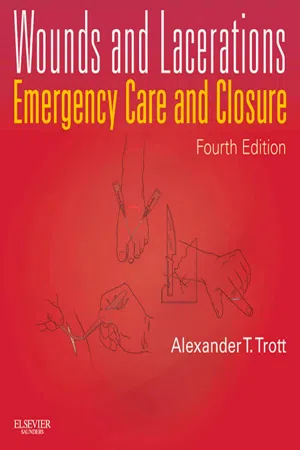
- 336 pages
- English
- ePUB (mobile friendly)
- Available on iOS & Android
About this book
With Wounds and Lacerations: Emergency Care and Closure, you'll get clear, concise guidance on the latest techniques and strategies for treating lacerations, wounds, and burns. This medical reference book will help you optimize every aspect of patient care based on current literature and guidelines.- Expedite review and reference with a bulleted "Key Practice Points" section at the beginning of each chapter.- Quickly reference the latest recommendations for tetanus and rabies prophylaxis.- Implement the latest approaches for the use of ultrasound in foreign-body detection and removal; use of absorbable sutures on the face and hand; approaching complicated infections such as MRSA; managing chronic wounds seen in elderly and diabetic patients; applying new suture techniques and materials for pediatric patients; and updated recommendations for tetanus and rabies prophylaxis.- Get step-by-step visual guidance on all aspects of wound care through more than 300 detailed line drawings and photographs showing techniques for wound assessment, irrigation, closure, wound dressing, foreign body removal, administration of local anesthesia, and follow-up care.- Quickly find all the relevant information necessary to treat patients with material that focuses only on injuries that are handled by emergency physicians.- On the scene or at the hospital, search the complete contents online at expertconsult.com.
Frequently asked questions
- Essential is ideal for learners and professionals who enjoy exploring a wide range of subjects. Access the Essential Library with 800,000+ trusted titles and best-sellers across business, personal growth, and the humanities. Includes unlimited reading time and Standard Read Aloud voice.
- Complete: Perfect for advanced learners and researchers needing full, unrestricted access. Unlock 1.4M+ books across hundreds of subjects, including academic and specialized titles. The Complete Plan also includes advanced features like Premium Read Aloud and Research Assistant.
Please note we cannot support devices running on iOS 13 and Android 7 or earlier. Learn more about using the app.
Information







GOALS OF WOUND CLOSURE
PATIENT EXPECTATIONS
Table of contents
- Cover
- Title Page
- Copyright
- Dedication
- Editorial Coordinator
- Contributors
- Preface
- Table of Contents
- Chapter 1: Emergency Wound Care: An Overview
- Chapter 2: Patient Evaluation and Wound Assessment
- Chapter 3: Anatomy of Wound Repair
- Chapter 4: Wound Healing and Cosmetic Outcome
- Chapter 5: Wound Care and the Pediatric Patient
- Chapter 6: Infiltration and Nerve Block Anesthesia
- Chapter 7: Wound Cleansing and Irrigation
- Chapter 8: Instruments, Suture Materials, and Closure Choices
- Chapter 9: Decisions before Closure: Timing, Débridement, and Consultation
- Chapter 10: Basic Laceration Repair: Principles and Techniques
- Chapter 11: Complex Skin Wounds: Advanced Repair Techniques
- Chapter 12: Special Anatomic Sites
- Chapter 13: The Hand
- Chapter 14: Tissue Adhesives and Alternative Wound Closure
- Chapter 15: Bite Wounds
- Chapter 16: Common Wound Care Problems
- Chapter 17: Minor Thermal Burns
- Chapter 18: Cutaneous and Superficial Abscesses
- Chapter 19: Complicated, Chronic, and Aging Skin Wounds
- Chapter 20: Wound Dressing and Bandaging Techniques
- Chapter 21: Tetanus Immunity and Antibiotic Wound Prophylaxis
- Chapter 22: Suture Removal and Wound Aftercare
- Index